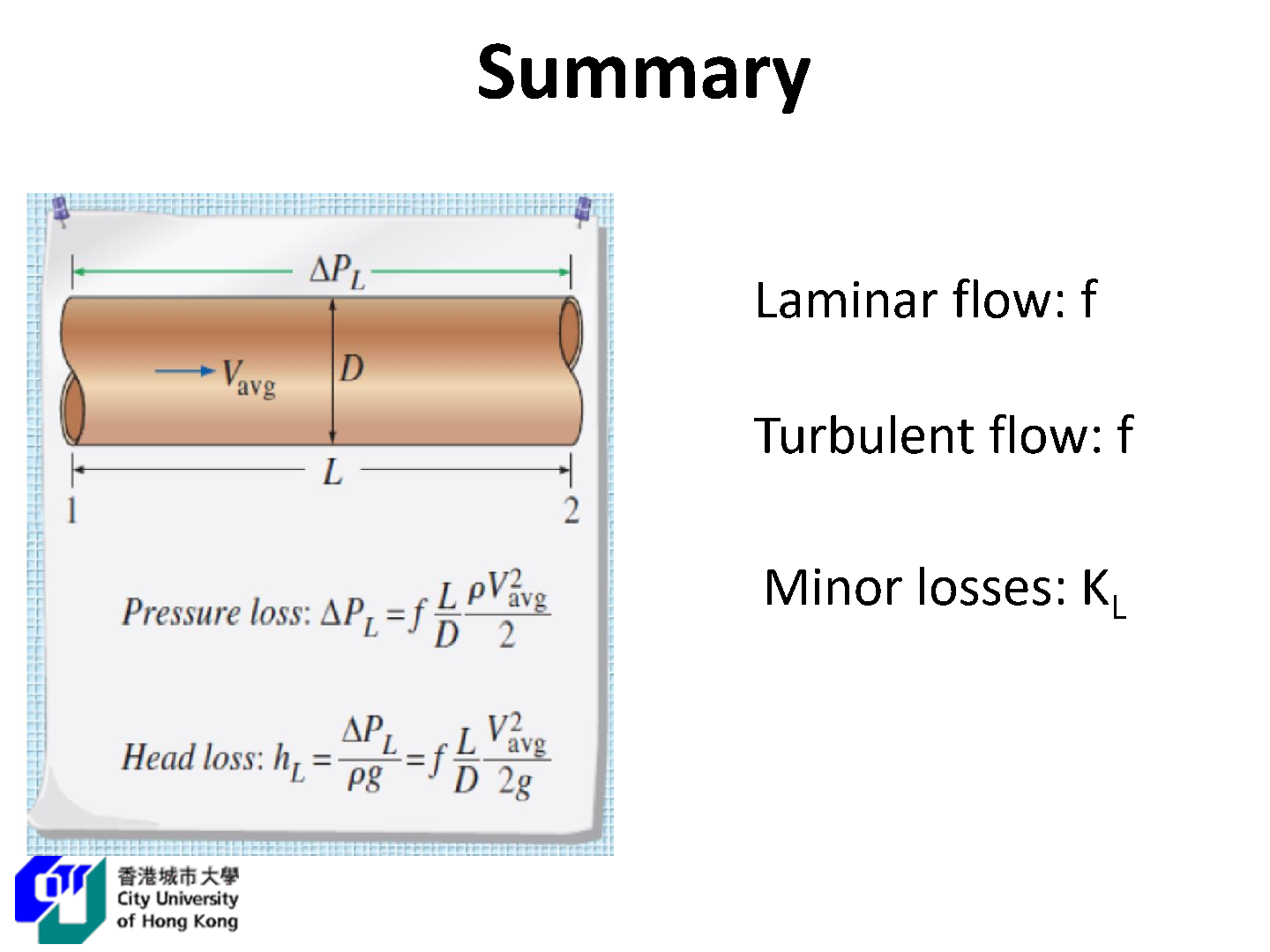Internal Flows
Introduction
- Liquid or gas flow through pipes or ducts is commonly used in heating and cooling applications and fluid distribution networks
- The fluid in such applications is usually forced to flow by a fan or a pump through a flow section.
- We pay particular attention to friction, which is directly related to pressure drop and head loss during flow through pipes and ducts
- The pressure drop is then used to determine the pumping power requirement.
Circular pipes can withstand large pressure difference between the inside and outside without undergoing any significant distortion.
However:
- Theoretical solutions are obtained only for a few simple cases such as fully developed laminar flow in a circular pipe
- Therefore, we must rely on experimental results and empirical relations for most fluidflow problem rather than closed-form analytical solutions.
The value of the average velocity
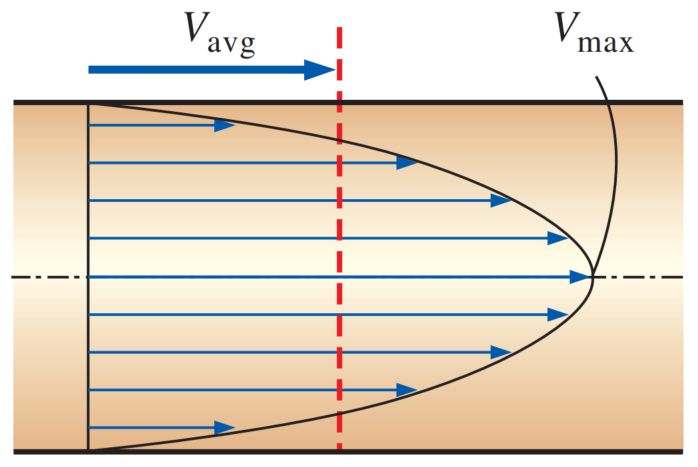
Average velocity
Laminar and Turbulent Flows
Laminar Flow in Pipes
We consider steady, laminar, incompressible flow of a fluid with constant properties in the fully developed region of a straight circular pipe.
In fully developed laminar flow:
- each fluid particle moves at a constant axial velocity along a streamline and the velocity profile
remains unchanged in the flow direction.
- There is no motion in the radial direction, and thus the velocity component in the direction normal to the pipe axis is everywhere zero.
- There is no acceleration since the flow is steady and fully developed.
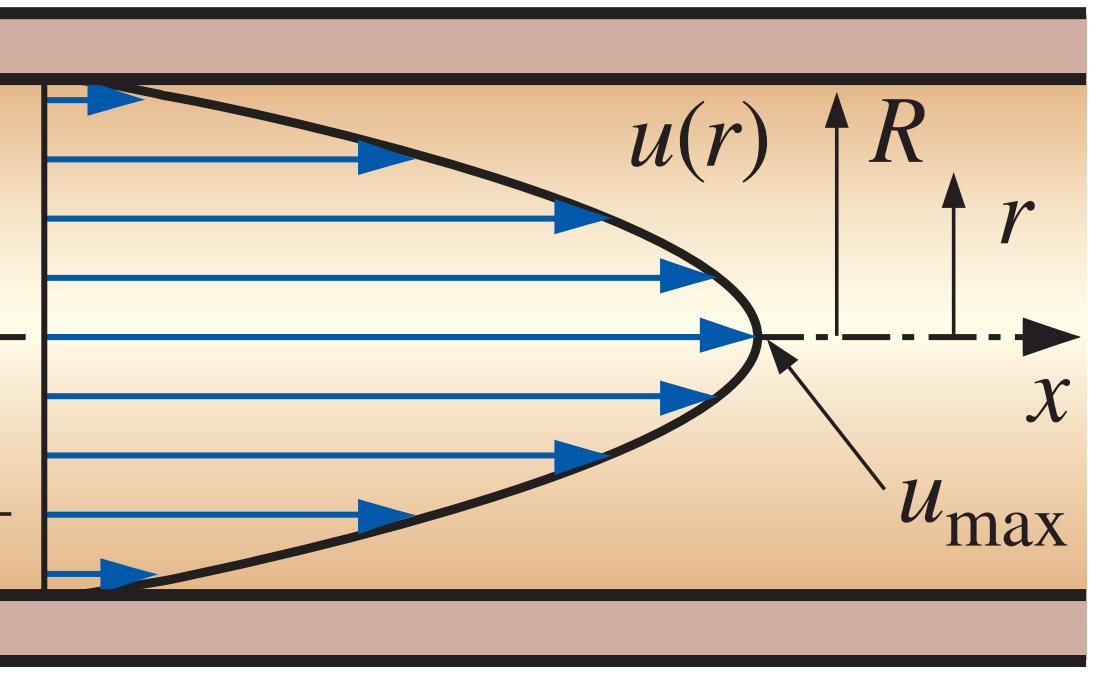
Laminar and Turbulent Flows
- Laminar: smooth streamlines and highly ordered motion
- Laminar flow is encountered when highly viscous fluids such as oils flow in small pipes or narrow passages.
- Transition: the flow fluctuates between laminar and turbulent flows.
- In the transitional flow region, the flow switches between laminar and turbulent seemingly random.
- Turbulent: ...
- Most flows encountered in practice are turbulent
Reynolds Number
The Reynolds number can be viewed as the ratio of inertial forces to viscous forces acting on a fluid element.
- At small Reynolds numbers, the viscous forces are large enough to suppress these fluctuations and to keep the fluid ‘in line’ (laminar).
- At large Reynolds numbers, the inertial forces, which are promotional to the fluid density and the fluid velocity, are large relative to viscous forces cannot prevent the viscous forces, and thus the random and rapid fluctuations of the fluid (turbulent).
Critical Reynolds number,
- The value of critical Reynolds number is different for different geometries and flow conditions
- For flow in circular pipe:
About the calculation of
where
- Circular tube with diameter
- Square duct with
: - Rectangular duct with
: - Channel with width
and height of fluid (not full, the height of channel is larger than ):
The Entrance Region
- Velocity boundary layer: The region of the flow in which the effects of the viscous shearing forces caused by fluid viscosity are felt.
- Boundary layer region: The viscous effects and the velocity changes are significant.
- Irrotational (core) flow region: The frictional effects are negligible and the velocity remains essentially constant in the radial direction.
The development of the velocity boundary layer in a pipe. The developed average velocity profile is parabolic in laminar flow, but somewhat flatter or fuller in turbulent flow.
Hydrodynamic entrance region: The region from the pipe inlet to the point at which the boundary layer merges at the centerline:
- Hydrodynamic entry length
: The length of this region. - Hydrodynamically developing flow: Flow in the entrance region. This is the region where the velocity profile develops.
- Hydrodynamic entry length
Hydrodynamically fully developed region: The region beyond the entrance region in which the velocity profile is fully developed and remains unchanged:
- Fully developed: When both the velocity profile and the normalized temperature profile remain unchanged.
In the fully developed flow region of a pipe, the velocity profile does not change downstream, and thus the wall shear stress
remains constant as well.
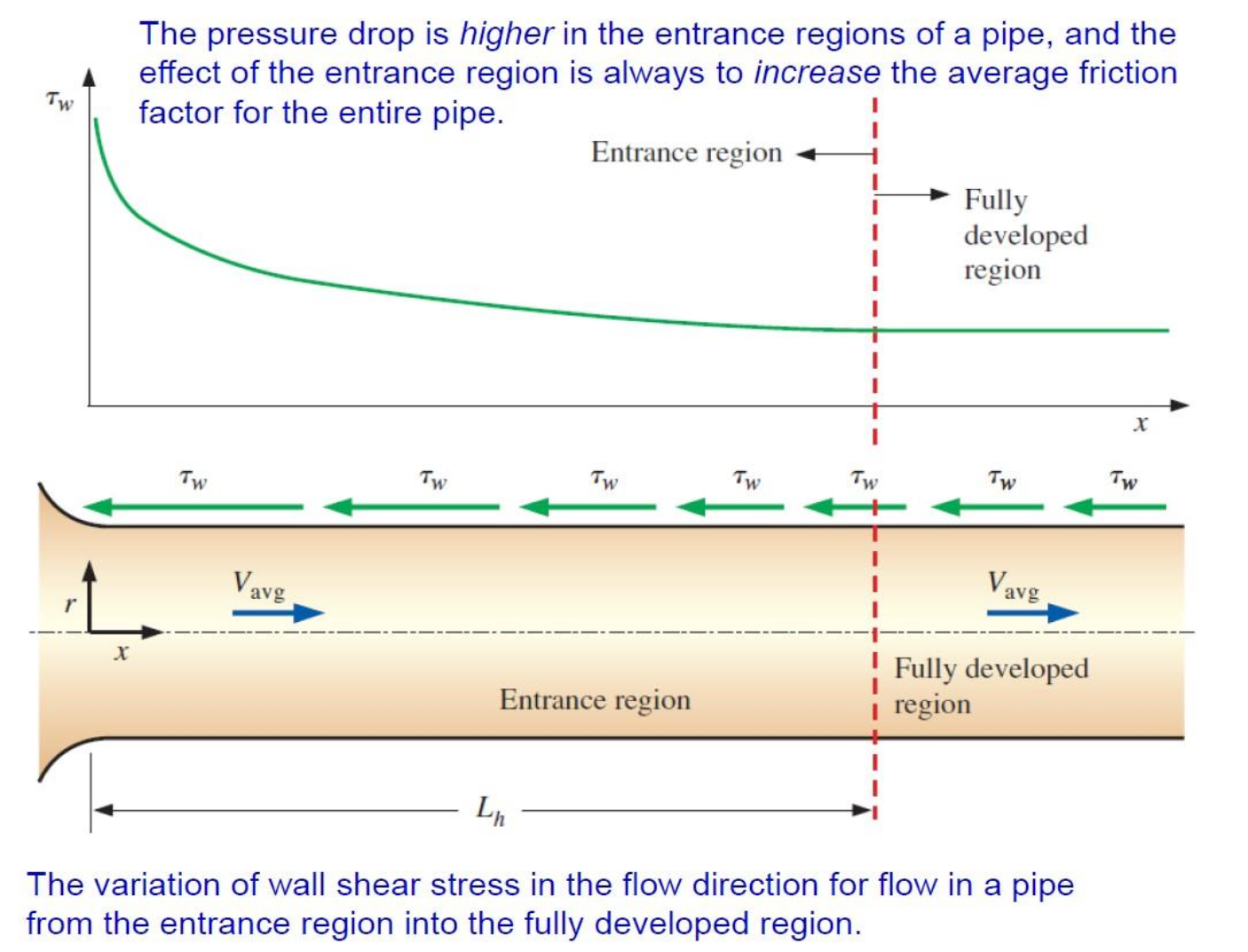
Entry Lengths
The hydrodynamic entry length
- For laminar flow:
- For turbulent flow:
- The pipes used in practice are usually several times the length of the entrance region, and thus the flow through the pipes is often assumed to be fully developed for the entire length of the pipe
- This simplistic approach gives reasonable results for long pipes but sometimes poor results for short ones since it underpredicts the wall shear stress and thus the friction factor
Quiz: Flow in a pipe is internal flow (T/F?)
True
Quiz: Open-channel flow, flow in a close reactor, flow in a closed valve, which one is NOT internal flow?
Open-channel flow
Quiz: The critical Reynolds number for pipe flow is
2300
Quiz:
ALL
Laminar Flow in pipes
Pressure Drop and Head Loss
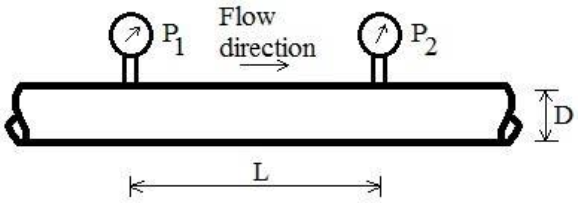
A quantity of interest in the analysis of pipe flow is the pressure drop
For the laminar flow:
Definition: pressure loss
A pressure drop due to viscous effects represents an irreversible pressure loss, and it is called pressure loss
for all types of fully developed internal flows, where
For laminar flow in the circular pipe:
In laminar flow, the friction factor is a function of the Reynolds number only and is independent of the roughness of the pipe surface.
Definition: head loss
The head loss represents the additional height that the fluid needs to be raised by a pump in order to overcome the frictional losses in the pipe:
The relation for pressure loss (and head loss)is one of the most general relations in fluid mechanics, and it is valid for laminar or turbulent flows, circular or noncircular pipes, and pipes with smooth or rough surfaces
For horizonal pipe:
where:
and the volume flow rate
The pumping power requirement for a laminar flow piping system can be reduced by a factor of
The pressure drop
This can be demonstrated by writing the energy equation for steady, imcompressible one-dimensional flow in terms of heads as
A useful equation to calculate the pressure drop for horizontal pipes and non-horizontal pipes
Laminar Flow in Noncircular Pipes
The friction factor f relations are given in Table below for fully developed laminar flow in pipes of various cross sections.
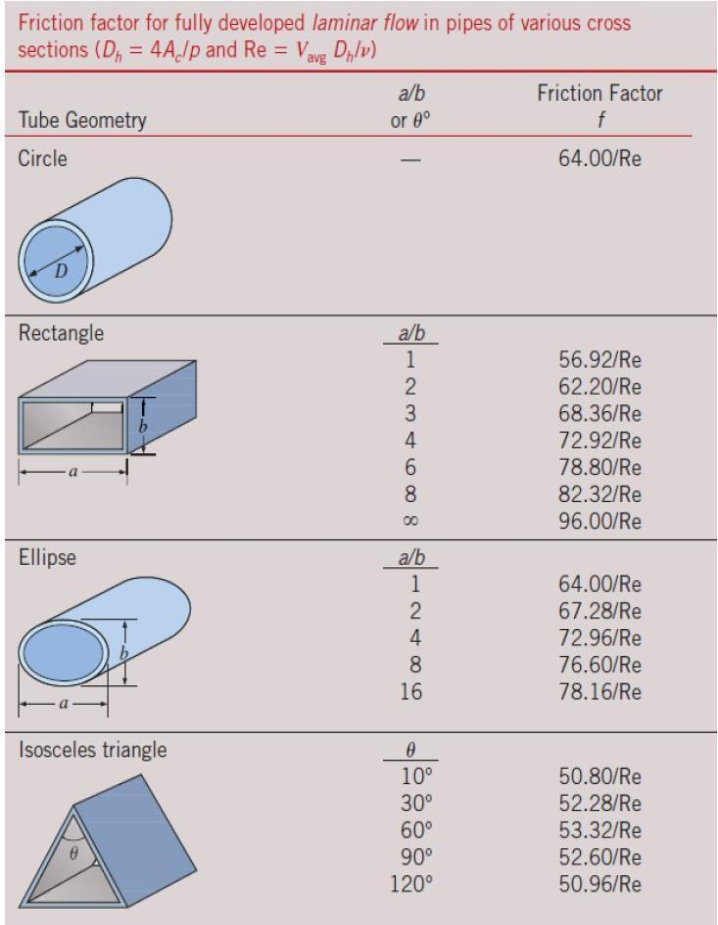
The Reynolds number for flow in these pipes is based on the hydraulic diameter
Quiz: For the fully developed laminar flow, we have
Quiz: A pressure drop due to () represents an irreversible pressure loss, and it is called pressure loss.
viscous effect
Examples1: Laminar Flow in Horizonal Pipes
Consider the fully developed flow of glycerin at
Properties: The density and dynamic viscosity of glycerin at
Analysis: The velocity profile in fully developed laminar flow in a circular pipe is expressed as
Substituting, the velocity profile is determined to be
where
which is less than 2300 . Therefore, the flow is indeed laminar. Then the friction factor and the head loss become
The energy balance for steady, incompressible one-dimensional flow is given by Eq. 8-28 as
For fully developed flow in a constant diameter pipe with no pumps or turbines,it reduces to
Then the pressure difference and the required useful pumping power for the horizontal case become
Example2: Pressure Drop and Head Loss in a Pipe
Water at
Properties: The density and dynamic viscosity of water are given to be
Analysis:
- First we need to determine the flow regime. The Reynolds number is
which is less than 2300 . Therefore, the flow is laminar. Then the friction factor and the head loss become
- Noting that the pipe is horizontal and its diameter is constant, the pressure drop in the pipe is due entirely to the frictional losses and is equivalent to the pressure loss,
- The volume flow rate and the pumping power requirements are
Therefore, power input in the amount of 0.28 W is needed to overcome the frictional losses in the flow due to viscosity.
Discussion: The pressure rise provided by a pump is often listed by a pump manufacturer in units of head (Chap. 14). Thus, the pump in this flow needs to provide 4.46 m of water head in order to overcome the irreversible head loss.
Turbulent Flow in Pipes
Most flows encountered in engineering practice are turbulent, and thus it is important to understand how turbulence affects wall shear stress.
Turbulent flow is a complex mechanism dominated by fluctuations, and it is still not fully understood.
We must rely on experiments and the empirical or semi-empirical correlations developed for various situations.
The intense mixing in turbulent flow brings fluid particles at different momentums into close contact and thus enhances momentum transfer.
Turbulent flow is characterized by disorderly and rapid fluctuations of swirling regions of fluid, called eddies, throughout the flow.
These fluctuations provide an additional mechanism for momentum and energy transfer.
In turbulent flow, the swirling eddies transport mass, momentum, and energy to other regions of flow much more rapidly than molecular diffusion, greatly enhancing mass, momentum, and heat transfer.
As a result, turbulent flow is associated with much higher values of friction, heat transfer, and mass transfer coefficients
Turbulent Velocity Profile
- viscous sublayer: The very thin layer next to the wall where viscous effects are dominant is the viscous (or laminar or linear or wall) sublayer
- The velocity profile in this layer is very nearly linear
- buffer layer: Next to the viscous sublayer is the buffer layer, in which turbulent effects are becoming significant, but the flow is still dominated by viscous effects
- overlap layer: Above the buffer layer is the overlap (or transition) layer, also called the inertial sublayer, in which the turbulent effects are much more significant, but still not dominant
- turbulent layer: Above that is the outer (or turbulent) layer in the remaining part of the flow in which turbulent effects dominate over molecular diffusion (viscous) effects
The velocity profile in fully developed pipe flow is parabolic in laminar flow, but much fuller in turbulent flow. Note that
quiz:
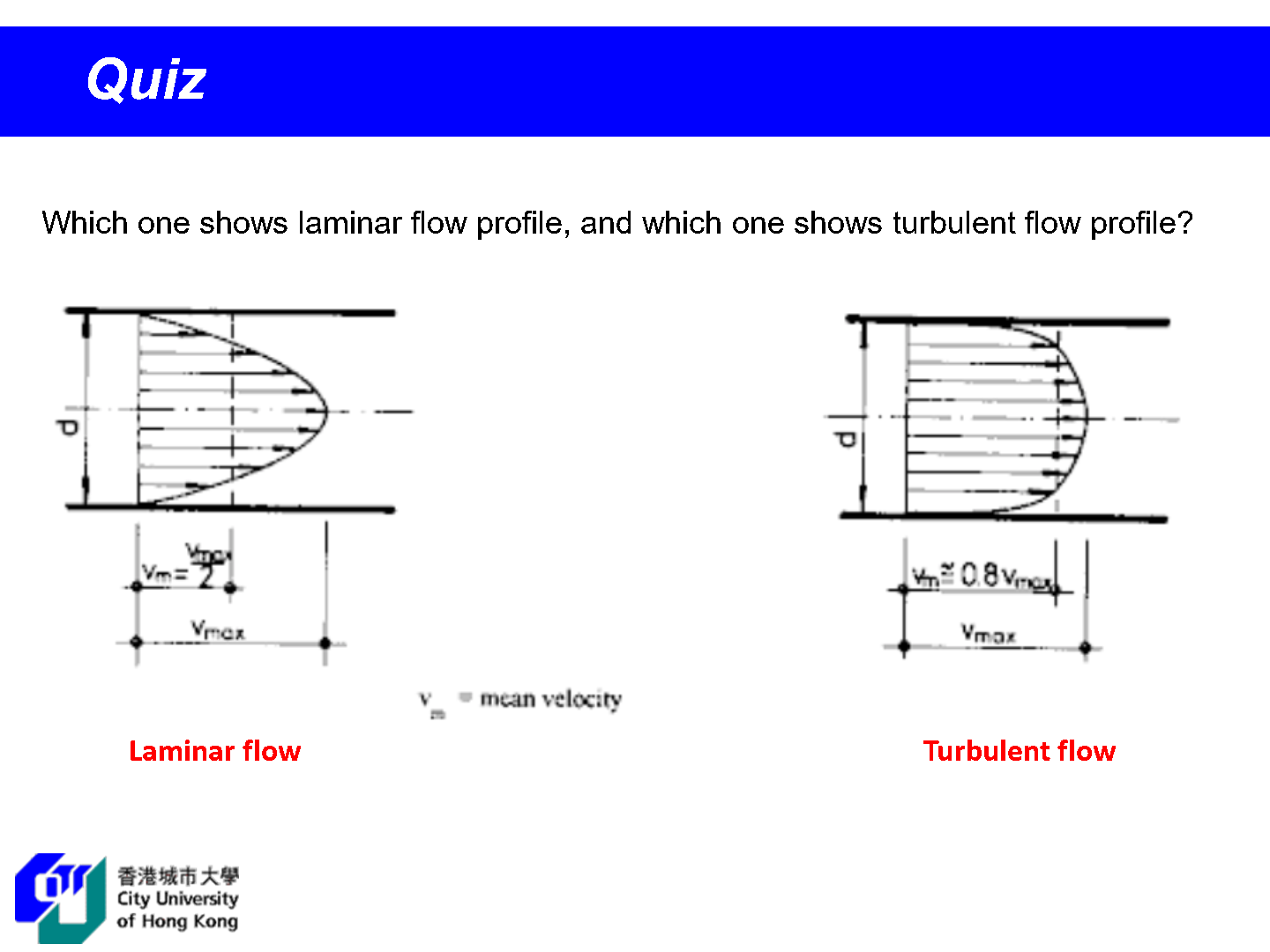
The Moody Chart and the Colebrook Equation
Colebrook Equation (turbulent flow for smooth and rough pipes):
- The friction factor in fully developed turbulent pipe flow depends on the Reynolds number and the relative roughness
. - The friction factor is minimum for a smooth pipe
and increases with roughness - The Colebrook equation is implicit in
since appears on both sides of the equation. It must be solved iteratively.
Here is the Moody Chart. It presents the Darcy friction factor for pipe flow as a function of Reynolds number and
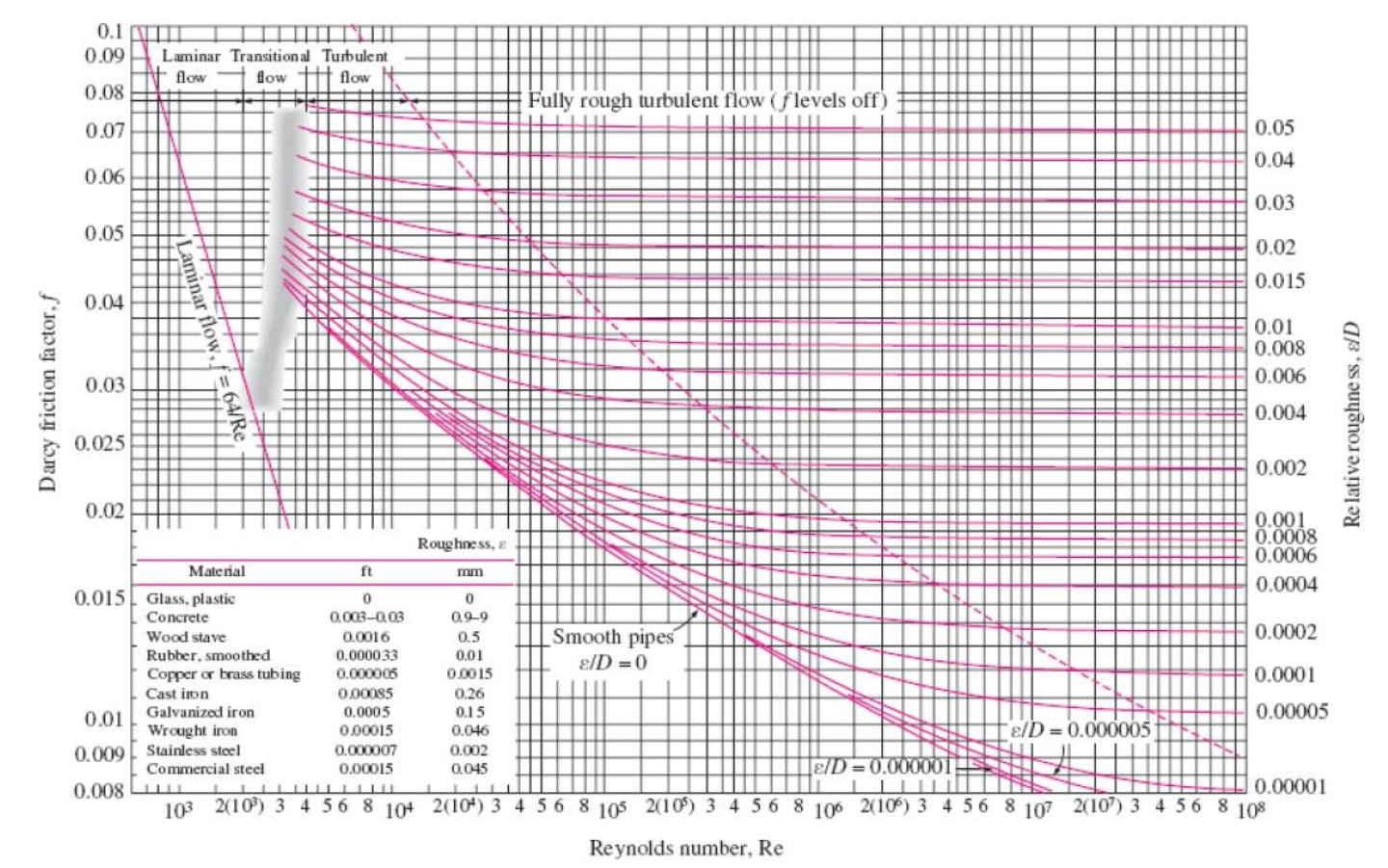
Quiz: In the ‘Fully Rough Zone’ for a given relative roughness, the friction factor is:
A constant
Types of Fluid Flow Problems
- Determining the pressure drop (or head loss) when the pipe length and diameter are given for a specified flow rate (or velocity)
- Determining the flow rate when the pipe length and diameter are given for a specified pressure drop (or head loss)
- Determining the pipe diameter when the pipe length and flow rate are given for a specified pressure drop (or head loss)
To avoid tedious iterations in head loss, flow rate, and diameter calculations, these explicit relations (Swamee-Jain formula) that are accurate to within 2 percent of the Moody chart may be used:
Example3: Determining the Head Loss in a Water Pipe
Water at
Properties: The density and dynamic viscosity of water are given
Analysis: We recognize this as a problem of the first type, since flow rate, pipe length, and pipe diameter are known. First we calculate the average velocity and the Reynolds number to determine the flow regime:
Since
The friction factor corresponding to this relative roughness and Reynolds number is determined from the Moody chart. To avoid any reading error, we determine
Using an equation solver or an iterative scheme, the friction factor is determined to be
Therefore, power input in the amount of
Discussion: It is common practice to write our final answers to three signififrictional digits, even though we know that the results are accurate to at most two significant digits because of inherent inaccuracies in the Colebrook equation, as discussed previously.
Example4: Determining the Diameter of an Air Duct [core]
Heated air at 1 atm and
Properties: The density, dynamic viscosity, and kinematic viscosity of air at
Analysis: This is a problem of the third type since it involves the determination of diameter for specified flow rate and head loss. We can solve this problem using three different approaches:
- an iterative approach by assuming a pipe diameter, calculating the head loss, comparing the result to the specified head loss, and repeating calculations until the calculated head loss matches the specified value;
- writing all the relevant equations (leaving the diameter as an unknown) and solving them simultaneously using an equation solver; and
- using the third Swamee-Jain formula. We will demonstrate the use of the last two approaches.
The average velocity, the Reynolds number, the friction factor, and the head loss relations are expressed as (
The roughness is approximately zero for a plastic pipe (Table 8-2). Therefore, this is a set of four equations and four unknowns, and solving them with an equation solver such as EES gives
Therefore, the diameter of the duct should be more than
The diameter can also be determined directly from the third Swamee-Jain formula to be
Example5: Determining the Flow Rate of Air in a Duct
Reconsider Example4. Now the duct length is doubled while its diameter is maintained constant. If the total head loss is to remain constant, determine the drop in the flow rate through the duct.
SOLUTION: The diameter and the head loss in an air duct are given. The drop in the flow rate is to be determined.
Analysis: This is a problem of the second type since it involves the determination of the flow rate for a specified pipe diameter and head loss. The solution involves an iterative approach since the flow rate (and thus the flow velocity) is not known.
The average velocity, Reynolds number, friction factor, and the head loss relations are expressed as (
The average velocity, Reynolds number, friction factor, and the head loss relations are expressed as (
This is a set of four equations in four unknowns and solving them with an equation solver such as EES gives
Then the drop in the flow rate becomes
Therefore, for a specified head loss (or available head or fan pumping power), the flow rate drops by about
Minor Losses
The fluid in a typical piping system passes through various fittings, valves, bends, elbows, tees, inlets, exits, enlargements, and contractions in addition to the pipes.
These components interrupt the smooth flow of the fluid and cause additional losses because of the flow separation and mixing they induce.
minor losses
In a typical system with long pipes, these losses are minor compared to the head loss in the straight sections (the major losses) and are called minor losses
For a constant-diameter section of a pipe with a minor loss component, the loss coefficient of the component (such as the gate valve shown) is determined by measuring the additional pressure loss it causes and dividing it by the dynamic pressure in the pipe.
Minor losses are usually expressed in terms of the loss coefficient
where
When the inlet diameter equals the outlet diameter, the loss coefficient of a component can also be determined by measuring the pressure loss across the component and dividing it by the dynamic pressure
When the loss coefficient for a component is available, the head loss for that component is determined from minor loss:
Minor losses are also expressed in terms of the equivalent length
The head loss caused by a component (such as the angle valve shown) is equivalent to the head loss caused by a section of the pipe whose length is the equivalent length.
Total head Losses
Once the loss coefficients are available, the total head loss in a piping system is determined from:
Example for Minor Losses
Sudden Expansion: All the kinetic energy of the flow is “lost” (turned into thermal energy) through friction as the jet decelerates and mixes with ambient fluid downstream of a submerged outlet.
The losses during changes of direction can be minimized by making the turn “easy” on the fluid by using circular arcs instead of sharp turns.
(a) The large head loss in a partially closed globe valve is due to irreversible deceleration, flow separation, and mixing of highvelocity fluid coming from the narrow valve passage.
(b) The head loss through a fully-open ball valve, on the other hand, is quite small. (Photo by John M. Cimbala)
Quiz: Major losses are greater than minor losses (T/F?)
False
Quiz: Slight rounding of the edge can result in a significant reduction of loss coefficient (T/F?)
True
Example6: Head Loss and Pressure Rise during Gradual Expansion
A 6-cm-diameter horizontal water pipe expands gradually to a 9-cm-diameter pipe (Fig. 8-43). The walls of the expansion section are angled
Assumptions
- The flow is steady and incompressible.
- The flow at sections 1 and 2 is fully developed and turbulent with
.
Properties: We take the density of water to be
Analysis: Noting that the density of water remains constant, the downstream velocity of water is determined from conservation of mass to be
Then the irreversible head loss in the expansion section becomes
Noting that
or
Solving for
Therefore,despite the head(and pressure)loss,the pressure increases from
Summary
